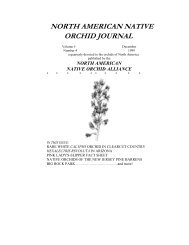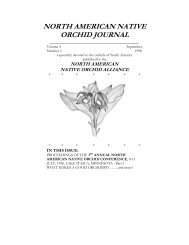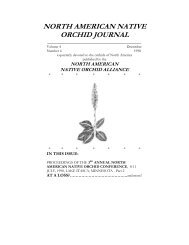north american native orchid journal - at The Culture Sheet
north american native orchid journal - at The Culture Sheet
north american native orchid journal - at The Culture Sheet
Create successful ePaper yourself
Turn your PDF publications into a flip-book with our unique Google optimized e-Paper software.
Empiricist: JEWELS IN THE MOST UNLIKELY PLACES<br />
British Columbia. In the Olympics of western Washington the<br />
Alaskan <strong>orchid</strong>, Piperia unalascensis, grows in a dwarf form (forma<br />
olympica) and down in Port Angles roadsides abound with up to<br />
five species of Piperia!<br />
Old cemeteries th<strong>at</strong> don’t get mowed frequently have<br />
habit<strong>at</strong>s th<strong>at</strong> invite <strong>orchid</strong>s to colonize them. New England is rich<br />
with small cemeteries th<strong>at</strong> yield the ardent explorer with<br />
handsome rewards. One such cemetery in Connecticut has<br />
Spiranthes lacera var. gracilis, southern slender ladies’-tresses, and<br />
several hybrids as well as S. vernalis, grass-leaved ladies’-tresses,<br />
flowering in mid-August.<br />
You don’t always need a neglected old cemetery to find an<br />
<strong>orchid</strong> jewel. Florida has a cemetery where dancing lady <strong>orchid</strong>s.<br />
Tolumnia bahamense, grows in the undeveloped areas. It is here the<br />
Florida rosemary bushes afford the <strong>orchid</strong> an opportunity to<br />
climb and flower with charming cascades of butterfly-like<br />
blossoms. <strong>The</strong>y appear to be doing a st<strong>at</strong>ely gavotte in the gentle<br />
breeze.<br />
Sometimes vacant lots or abandoned housing<br />
developments offer <strong>orchid</strong>s the right conditions to seed in<br />
although more often the <strong>orchid</strong>s have been destroyed by the<br />
clearing and bulldozing. Those <strong>orchid</strong>s th<strong>at</strong> are successional may<br />
take up residences as n<strong>at</strong>ure reclaims the area. A borrow pit in<br />
southern New Hampshire th<strong>at</strong> was cleared for a golf driving range<br />
th<strong>at</strong> failed is filled with grass pinks, Calopogon tuberosus, and rose<br />
pogonia, Pogonia ophioglossoides, and a few <strong>north</strong>ern tubercled<br />
<strong>orchid</strong>s, Pl<strong>at</strong>anthera flava var. herbiola, are starting to show up. Of<br />
course, several species of Spiranthes are found throughout the pit<br />
habit<strong>at</strong>. Succession is claiming the area though and poplars,<br />
willows, and other trees have seeded in as n<strong>at</strong>ure reforests the<br />
clearing chasing out the <strong>orchid</strong>s. In housing developments th<strong>at</strong><br />
never m<strong>at</strong>erialized in California and Washington, and Florida we<br />
have found <strong>orchid</strong>s in the ditches as well as the vacant lots.<br />
Florida yielded wild coco, Eulophia alta, w<strong>at</strong>er-spider <strong>orchid</strong>s,<br />
Habenaria repens, and a variety of Spiranthes of course. Wet ditches<br />
in otherwise dry areas in California had Epipactis gigantea,<br />
37













